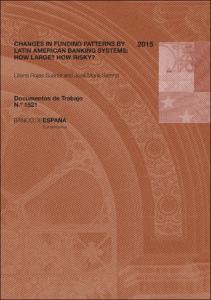Registro completo de metadatos
| Campo DC | Valor |
|---|---|
| dc.contributor.author | Rojas-Suárez, Liliana |
| dc.contributor.author | Serena, José María |
| dc.coverage.spatial | América Latina |
| dc.date.accessioned | 2019-08-10T18:08:40Z |
| dc.date.available | 2019-08-10T18:08:40Z |
| dc.date.issued | 2015-07-24 |
| dc.identifier.issn | ISSN: 1579-8666 (en línea) |
| dc.identifier.uri | https://repositorio.bde.es/handle/123456789/7195 |
| dc.description.abstract | Este trabajo investiga los cambios en los patrones de financiación de los bancos de América Latina tras la crisis financiera global. Para ello introducimos una nueva medida de la exposición de los sistemas bancarios locales a los mercados internacionales de deuda: emisiones internacionales de deuda de las entidades supervisadas localmente. En contraste con las métricas del BPI habitualmente empleadas, la nuestra incluye todas las entidades que están bajo la supervisión de la autoridad local. Esto es especialmente importante en América Latina, donde la participación de los bancos extranjeros establecidos como entidades independientes y enteramente participadas es muy amplia. Empleando esta métrica, encontramos que todos los tipos de grupos bancarios aumentaron de modo significativo y acusado sus emisiones de deuda internacional. Debido a las bajas ratios de deuda externa de partida, sólidas ratios de solvencia y mejora en la capacidad supervisora, el reciente incremento en el endeudamiento externo de los bancos no ha llevado a dificultades financieras y los sistemas bancarios se mantienen sólidos. Sin embargo, un análisis preliminar de los riesgos de esta nueva tendencia muestra la emergencia de varios signos de vulnerabilidad. En primer lugar, en algunos sistemas bancarios (en particular, los bancos brasileños) el incremento en las emisiones de deuda se ha visto acompañado por mayor uso de financiación mayorista. En contraste, este se ha mantenido bajo y estable en los bancos colombianos. En segundo lugar, los riesgos de refinanciación han aumentado significativamente en los grupos bancarios latinoamericanos. Los vencimientos de deuda, que aumentaron notablemente en 2013-2014, se mantendrán en niveles elevados en 2015-2016, en un contexto de notables incertidumbres en los mercados internacionales. Este riesgo es particularmente notable en Brasil y en Chile. En tercer lugar .. |
| dc.description.abstract | This paper investigates the shifts in Latin American banks’ funding patterns in the postglobal financial crisis period. To this end we introduce a new measure of exposure of local banking systems to international debt markets that we term: International Debt Issuances by Locally Supervised Institutions. In contrast to well-known BIS measures, our new metric includes all entities that fall under the supervisory purview of the local authority. This is especially important in Latin America, where the participation of foreign banks that are established as independent, fully-capitalized entities is most substantial. Using this metric we found that all types of Latin American banking groups increased significantly and sharply their issuance of external debt securities. Owing to the low ratios of banks’ external debt to total liabilities in the pre-crisis period, solid solvency ratios and improved supervisory capacity, the recent increase in banks’ external indebtedness has not resulted in financial difficulties and banking systems remain strong. However, a preliminary analysis of risks based on this new trend reveals the emergence of several signs of increased vulnerability. First, in some banking groups (particularly in Brazilian banks, domestic and foreign alike) the increased issuance of external debt has been accompanied by a greater reliance on wholesale funding. In contrast, reliance on wholesale funding by Colombian banks has remained low and stable. Second, rollover risks have significantly increased for Latin American banking groups. Maturing debt, which increased significantly in 2013-14, will continue at high levels in 2015-16 in the context of major uncertainties in international capital markets. This risk is especially noticeable in Brazil and Chile, whose ratios of maturing debt to total debt are high. Third, in spite of a sizeable accumulation of international reserves .. |
| dc.format.extent | 45 p. : gráf., tab., fórmulas |
| dc.language.iso | en |
| dc.publisher | Banco de España |
| dc.relation.ispartof | Documentos de Trabajo / Banco de España, 1521 |
| dc.rights | Reconocimiento-NoComercial-CompartirIgual 4.0 Internacional (CC BY-NC-SA 4.0) |
| dc.rights | In Copyright - Non Commercial Use Permitted |
| dc.rights.uri | https://creativecommons.org/licenses/by-nc-sa/4.0/deed.es_ES |
| dc.rights.uri | http://rightsstatements.org/vocab/InC-NC/1.0/ |
| dc.subject | Bancos de economías emergentes |
| dc.subject | Entidades bajo supervisión local |
| dc.subject | Deuda internacional |
| dc.subject | Financiación mayorista |
| dc.subject | América Latina y fragilidades financieras |
| dc.subject | Emerging economies´ banks |
| dc.subject | Locally supervised institutions |
| dc.subject | International debt |
| dc.subject | Wholesale funding |
| dc.subject | Latin America and financial fragilities |
| dc.title | Changes in funding patterns by Latin American banking systems : how large? how risk? |
| dc.type | Documento de trabajo |
| dc.identifier.bdebib | 000354362 |
| dc.identifier.bdepub | DTRA-201521-eng |
| dc.subject.bde | Mercados de dinero |
| dc.subject.bde | Finanzas internacionales |
| dc.subject.bde | Instituciones crediticias de depósito |
| dc.publisher.bde | Madrid : Banco de España, 2015 |
| dc.subject.jel | G15 |
| dc.subject.jel | G21 |
| dc.subject.jel | F36 |












